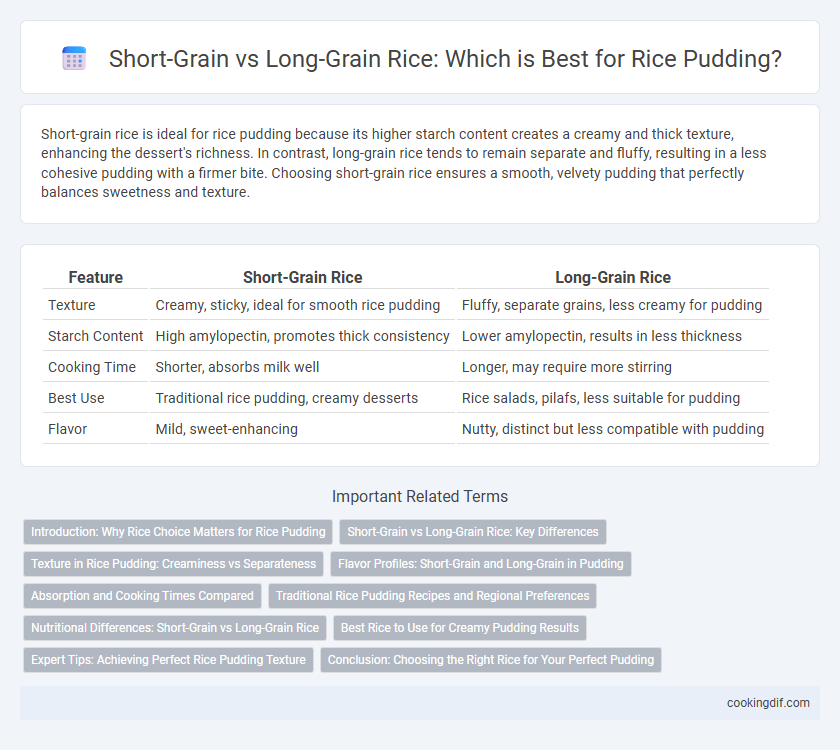Short-grain rice is ideal for rice pudding because its higher starch content creates a creamy and thick texture, enhancing the dessert's richness. In contrast, long-grain rice tends to remain separate and fluffy, resulting in a less cohesive pudding with a firmer bite. Choosing short-grain rice ensures a smooth, velvety pudding that perfectly balances sweetness and texture.
Table of Comparison
| Feature | Short-Grain Rice | Long-Grain Rice |
|---|---|---|
| Texture | Creamy, sticky, ideal for smooth rice pudding | Fluffy, separate grains, less creamy for pudding |
| Starch Content | High amylopectin, promotes thick consistency | Lower amylopectin, results in less thickness |
| Cooking Time | Shorter, absorbs milk well | Longer, may require more stirring |
| Best Use | Traditional rice pudding, creamy desserts | Rice salads, pilafs, less suitable for pudding |
| Flavor | Mild, sweet-enhancing | Nutty, distinct but less compatible with pudding |
Introduction: Why Rice Choice Matters for Rice Pudding
Short-grain rice is ideal for rice pudding due to its higher starch content, which creates a creamy and smooth texture essential for traditional recipes. In contrast, long-grain rice retains a firmer, drier consistency, making it less effective at absorbing milk and sugar. Choosing the right rice variety directly impacts the pudding's flavor, creaminess, and overall mouthfeel.
Short-Grain vs Long-Grain Rice: Key Differences
Short-grain rice absorbs more liquid and releases higher starch content, making it ideal for creamy rice pudding with a smooth, sticky texture. Long-grain rice has less amylopectin, resulting in a fluffier, less cohesive pudding with distinct grains. Selecting short-grain rice enhances the richness and thickness essential for traditional rice pudding recipes.
Texture in Rice Pudding: Creaminess vs Separateness
Short-grain rice offers a creamier texture in rice pudding due to its higher starch content, which releases more amylopectin, creating a rich and velvety consistency. Long-grain rice, such as Basmati, maintains a firmer, more separate grain structure, resulting in a drier pudding with distinct rice grains. The choice between short-grain and long-grain rice significantly impacts the mouthfeel, with short-grain preferred for traditional, creamy rice pudding recipes.
Flavor Profiles: Short-Grain and Long-Grain in Pudding
Short-grain rice delivers a creamy, rich texture in rice pudding due to its higher starch content, enhancing the dessert's smoothness and sweetness. Long-grain rice produces a lighter, fluffier pudding with a subtle flavor, allowing added spices and ingredients to stand out more distinctly. Choosing short-grain rice intensifies the pudding's comforting mouthfeel, while long-grain rice offers a more delicate balance of flavors and textures.
Absorption and Cooking Times Compared
Short-grain rice absorbs liquid more efficiently than long-grain rice, making it ideal for creamy rice pudding textures. The higher starch content in short-grain rice shortens cooking times, typically around 20-25 minutes, compared to long-grain rice which may take 30-40 minutes and results in a drier texture. Choosing short-grain rice ensures optimal moisture retention and smooth consistency in traditional rice pudding recipes.
Traditional Rice Pudding Recipes and Regional Preferences
Short-grain rice is favored in traditional rice pudding recipes for its high starch content, which creates a creamy and thick texture essential for authentic dishes like British and Indian kheer. Long-grain rice varieties, such as Basmati, are preferred in some Middle Eastern and Persian rice puddings, where a fluffier and less sticky consistency is desired. Regional preferences reflect these textural differences, with short-grain rice dominating European puddings and long-grain rice common in Middle Eastern culinary traditions.
Nutritional Differences: Short-Grain vs Long-Grain Rice
Short-grain rice contains higher amylopectin, resulting in a creamier texture ideal for rice pudding, while long-grain rice is lower in amylopectin but higher in amylose, providing a firmer consistency. Nutritionally, short-grain rice offers slightly more carbohydrates and calories per serving, whereas long-grain rice tends to have a marginally higher fiber content and lower glycemic index. Both varieties provide essential nutrients like B vitamins and minerals, but the choice impacts pudding texture and digestion rates.
Best Rice to Use for Creamy Pudding Results
Short-grain rice is the best choice for creamy rice pudding due to its high starch content, which thickens the dessert and creates a rich, velvety texture. Long-grain rice has less starch and tends to stay separate and fluffy, resulting in a less cohesive pudding. For optimal creaminess and smooth consistency, use varieties such as Arborio or sushi rice that release more amylopectin during cooking.
Expert Tips: Achieving Perfect Rice Pudding Texture
Short-grain rice is ideal for rice pudding due to its high starch content, which creates a creamy and cohesive texture essential for a rich dessert. Long-grain rice, with lower amylopectin levels, tends to remain separate and less sticky, resulting in a grainier pudding texture. Experts recommend soaking short-grain rice before cooking and stirring continuously to enhance the smooth, velvety consistency characteristic of classic rice pudding.
Conclusion: Choosing the Right Rice for Your Perfect Pudding
Short-grain rice, with its higher starch content, creates a creamier and thicker texture ideal for rice pudding, while long-grain rice tends to remain separate and less sticky, resulting in a lighter consistency. Choosing short-grain rice ensures a smooth, rich pudding that holds together well, enhancing the dessert's indulgence and mouthfeel. For a traditional, velvety rice pudding, prioritize short-grain varieties like Arborio or sushi rice to achieve optimal creaminess and flavor absorption.
Short-grain rice vs Long-grain rice for rice pudding Infographic

 cookingdif.com
cookingdif.com